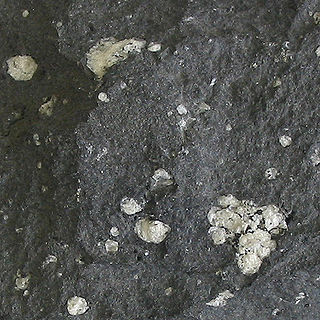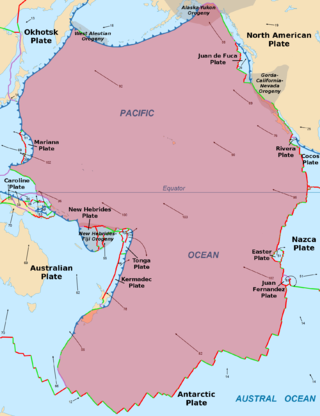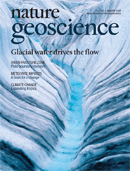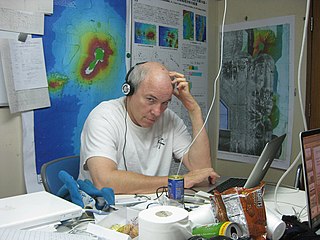
Oceanic trenches are prominent, long, narrow topographic depressions of the ocean floor. They are typically 50 to 100 kilometers wide and 3 to 4 km below the level of the surrounding oceanic floor, but can be thousands of kilometers in length. There are about 50,000 km (31,000 mi) of oceanic trenches worldwide, mostly around the Pacific Ocean, but also in the eastern Indian Ocean and a few other locations. The greatest ocean depth measured is in the Challenger Deep of the Mariana Trench, at a depth of 10,994 m (36,070 ft) below sea level.

Subduction is a geological process in which the oceanic lithosphere and some continental lithosphere is recycled into the Earth's mantle at the convergent boundaries between tectonic plates. Where one tectonic plate converges with a second plate, the heavier plate dives beneath the other and sinks into the mantle. A region where this process occurs is known as a subduction zone, and its surface expression is known as an arc-trench complex. The process of subduction has created most of the Earth's continental crust. Rates of subduction are typically measured in centimeters per year, with rates of convergence as high as 11 cm/year.

An ophiolite is a section of Earth's oceanic crust and the underlying upper mantle that has been uplifted and exposed, and often emplaced onto continental crustal rocks.

A convergent boundary is an area on Earth where two or more lithospheric plates collide. One plate eventually slides beneath the other, a process known as subduction. The subduction zone can be defined by a plane where many earthquakes occur, called the Wadati–Benioff zone. These collisions happen on scales of millions to tens of millions of years and can lead to volcanism, earthquakes, orogenesis, destruction of lithosphere, and deformation. Convergent boundaries occur between oceanic-oceanic lithosphere, oceanic-continental lithosphere, and continental-continental lithosphere. The geologic features related to convergent boundaries vary depending on crust types.

Andesite is a volcanic rock of intermediate composition. In a general sense, it is the intermediate type between silica-poor basalt and silica-rich rhyolite. It is fine-grained (aphanitic) to porphyritic in texture, and is composed predominantly of sodium-rich plagioclase plus pyroxene or hornblende.

The Pacific plate is an oceanic tectonic plate that lies beneath the Pacific Ocean. At 103 million km2 (40 million sq mi), it is the largest tectonic plate.

The islands of Japan are primarily the result of several large ocean movements occurring over hundreds of millions of years from the mid-Silurian to the Pleistocene, as a result of the subduction of the Philippine Sea Plate beneath the continental Amurian Plate and Okinawa Plate to the south, and subduction of the Pacific Plate under the Okhotsk Plate to the north.

The Alpide belt or Alpine-Himalayan orogenic belt, or more recently and rarely the Tethyan orogenic belt, is a seismic and orogenic belt that includes an array of mountain ranges extending for more than 15,000 kilometres (9,300 mi) along the southern margin of Eurasia, stretching from Java and Sumatra, through the Indochinese Peninsula, the Himalayas and Transhimalayas, the mountains of Iran, Caucasus, Anatolia, the Mediterranean, and out into the Atlantic.

Nature Materials is a monthly peer-reviewed scientific journal published by Nature Portfolio. It was launched in September 2002. Vincent Dusastre is the launching and current chief editor.

Journal of the Physical Society of Japan (JPSJ) is a monthly, peer-reviewed, scientific journal published by the Physical Society of Japan (JPS). It was first published in July 1946. The editor-in-chief was A. Kawabata until August 2010. The impact factor for JPSJ in 2017 is 1.485, according to Journal Citation Reports.

The Izu–Bonin–Mariana (IBM) arc system is a tectonic plate convergent boundary in Micronesia. The IBM arc system extends over 2800 km south from Tokyo, Japan, to beyond Guam, and includes the Izu Islands, the Bonin Islands, and the Mariana Islands; much more of the IBM arc system is submerged below sealevel. The IBM arc system lies along the eastern margin of the Philippine Sea plate in the Western Pacific Ocean. It is the site of the deepest gash in Earth's solid surface, the Challenger Deep in the Mariana Trench.
The following outline is provided as an overview of and topical guide to geology:

Nature Geoscience is a monthly peer-reviewed scientific journal published by the Nature Publishing Group. The Chief Editor is Tamara Goldin, who took over from Heike Langenberg in February 2020. It was established in January 2008.
Masaaki Kimura is a Japanese geologist and a professor emeritus from the Faculty of Science of the University of the Ryukyus, Okinawa, Japan.
The International Journal of Modern Physics is a series of physics journals published by World Scientific.

Physics of the Earth and Planetary Interiors, established in October 1967, is a biweekly peer-reviewed scientific journal published by Elsevier. The co-editors are A. Ferreira, K. Hirose, D. Jault, and C. Michaut.
Elements: An International Magazine of Mineralogy, Geochemistry, and Petrology is a bimonthly peer-reviewed scientific journal published by 18 scientific societies: Mineralogical Society of America, Mineralogical Society of Great Britain and Ireland, Mineralogical Association of Canada, Clay Minerals Society, Geochemical Society, European Association of Geochemistry, International Association of GeoChemistry, Société Française de Minéralogie et de Cristallographie, Association of Applied Geochemists, Deutsche Mineralogische Gesellschaft, Società Italiana di Mineralogia e Petrologia, International Association of Geoanalysts, Polskie Towarzystwo Mineralogiczne, Sociedad Española de Mineralogía, Swiss Society of Mineralogy and Petrology, Meteoritical Society, Japan Association of Mineralogical Sciences and the International Association on the Genesis of Ore Deposits. It was established in January 2005.
The Journal of Photochemistry and Photobiology is a series of peer-reviewed scientific journals covering the fields of photochemistry and photobiology, published by Elsevier. It was originally established in 1972, and split into Journal of Photochemistry and Photobiology A: Chemistry and Journal of Photochemistry and Photobiology B: Biology in 1987. A third title; Journal of Photochemistry and Photobiology C: Photochemistry Reviews, was established in 2000 and is the official journal of the Japanese Photochemistry Association.

Robert James (Bob) Stern is an American geoscientist based in Texas.

The eastern margin of the Sea of Japan is a zone of concentrated geological strain which extends several hundred kilometers and north–south along the eastern margin of the Sea of Japan. The margin has undergone convergence tectonics since the end of the Pliocene. It is believed to be an incipient subduction zone which defines the tectonic boundary between the Amurian and Okhotsk plates. This geological zone is seismically active and has been the source of destructive tsunamis. The feature runs off the west coast of Honshu, passes west of the Shakotan Peninsula on Hokkaido and through the Strait of Tartary, between Sakhalin and mainland Russia.













